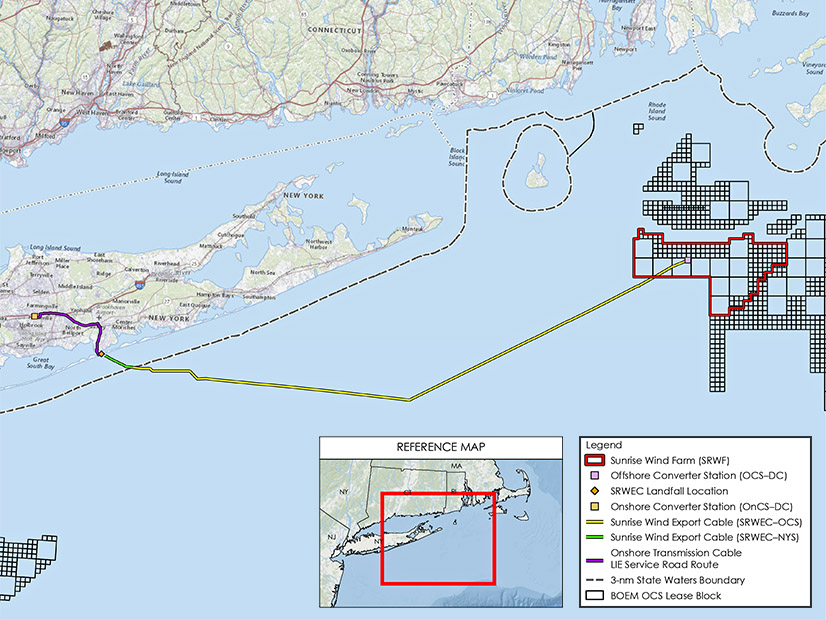Sunrise Wind has received final federal approval of its construction and operations plan and expects to begin seabed preparations off the New England coast this year.
The Bureau of Ocean Energy Management announced the decision June 21. BOEM had formally greenlighted the project with its record of decision March 26, but other pieces of the review process remained.
BOEM’s final approval clears the way for offshore construction of the 924-MW project, which will be the second offshore wind farm to feed into the New York grid and the third project begun by the Ørsted/Eversource partnership. Sunrise’s onshore transmission infrastructure preparations have been underway for months and now will accelerate.
The June 21 announcement was BOEM’s third offshore wind update in four days.
BOEM said June 20 it had determined its plan to lease parts of the Gulf of Maine for wind energy development would have minimal environmental impact, and on June 18, it issued a call for input as it begins to consider a wind lease auction off the coast of a U.S. territory, tentatively targeted for 2028.
Sunrise Wind
The announcements that Sunrise Wind could and would begin construction complete a turnaround from a remarkably bad year for that project and for most other wind farms planned along the Northeast U.S. coast, as soaring costs made offtake contracts negotiated years earlier untenable.
New York state rejected Sunrise’s request for more money in late 2023 but invited a rebid in a rush solicitation. Sunrise submitted a new bid with much higher costs, and New York announced a new contract June 4.
Along the way, Ørsted and Eversource recorded billions of dollars in impairments and losses from their joint venture. There also were some high points: This year, the partners completed South Fork Wind, the first utility-scale wind farm in U.S. waters, and started construction on Revolution Wind.
The two companies are in the late stages of terminating their partnership — Eversource has decided to limit its work in the offshore wind sector to onshore transmission infrastructure. It has reached deals to sell its share of Sunrise to Ørsted and its share of South Fork and Revolution to Global Infrastructure Partners.
“Sunrise Wind is a centerpiece of New York’s clean energy vision, and with this final federal approval, we can officially put the construction phase in motion,” Ørsted Americas CEO David Hardy said in a news release. “BOEM’s approval is an important milestone not just for New York, but also for America’s domestic energy sector.”
Sunrise Wind is to be built in lease area OCS-A 0487, which is 109,952 acres situated more than 30 miles east of the eastern tip of Long Island, closer to Massachusetts and Rhode Island than to New York.
Sunrise is targeted to come online in 2026. Its export cable will stretch about 100 miles to Holbrook on the south shore of Long Island. Port Jefferson Harbor, on the north shore, will host the operations and maintenance hub.
Gulf of Maine
The Gulf of Maine draft environmental analysis announced June 20 is a preparatory step for the auction of up to eight lease areas totaling nearly 1 million acres and holding the potential for up to 15 GW of wind generation capacity.
The Department of the Interior announced in April it is targeting such an auction for 2024. Also this year, it hopes to auction leases in Central Atlantic, Gulf of Mexico and Oregon regions.
The water is so deep in the Gulf of Maine and Oregon lease areas that wind power development there would rely on floating technology, which still is being developed.
The draft environmental assessment does not examine the environmental impact of installing and operating thousands of floating wind turbines off the Maine, New Hampshire and Massachusetts coasts.
It assesses only the reasonably foreseeable consequences of site characterization and site assessment activities that would occur as developers conduct the research that would form the basis of their construction and operation plans.
The draft analysis concludes this work would have negligible or negligible-to-minor impacts.
BOEM has been advancing the Biden administration’s offshore wind goals vigorously. While so far it has fended off legal challenges from wind power opponents, it has given consideration to feedback from stakeholders and the public.
BOEM reduced the number of turbines in the Sunrise Wind plan, for example, and reduced the size of the Gulf of Maine Wind Energy Area, both in response to concerns raised in public comment periods.
Before it finalizes the Gulf of Maine environmental analysis, BOEM once again is seeking feedback. A 30-day public comment period on the draft will run through July 22.
US Territories
On June 18, BOEM issued a request for suggestions for baseline environmental and socioeconomic studies that will shape its decisions about potential offshore wind development near U.S. territories.
BOEM also is looking for local entities that could carry out studies and environmental monitoring.
“BOEM develops, funds and manages rigorous scientific research to ensure our decisions are informed by the best science and Indigenous knowledge available,” Rodney Cluck, chief of BOEM’s Environmental Studies Program, said in a news release. “Additional research focused on the U.S. territories will increase our understanding of these important areas, and the potential impacts of offshore wind energy development on their residents and resources.”
The U.S. has territories in both the Caribbean Sea and Pacific Ocean, and BOEM’s request for letters of information references both regions.
The regulator is considering a wide range of study subjects, including sea turtles, whales, workforce capabilities, public values, submerged archaeological sites and larval dispersal.




